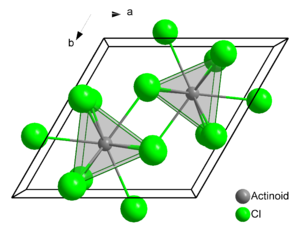- PuCl3
-
Kristallstruktur 
Kristallsystem hexagonal Raumgruppe 
Gitterkonstanten a = 739,4 pm
c = 424,3 pmKoordinationszahlen Pu[9], Cl[3] Allgemeines Name Plutonium(III)-chlorid Andere Namen Plutoniumtrichlorid
Verhältnisformel PuCl3 CAS-Nummer 13569-62-5 Kurzbeschreibung grüner Feststoff[1] Eigenschaften Molare Masse 350,32 g/mol Aggregatzustand fest
Dichte 5,71 g/cm3[2]
Schmelzpunkt 767 °C[2]
Siedepunkt 1767 °C[2]
Sicherheitshinweise Gefahrstoffkennzeichnung [3] keine Einstufung verfügbar R- und S-Sätze R: siehe oben S: siehe oben Radioaktivität 
RadioaktivSoweit möglich und gebräuchlich, werden SI-Einheiten verwendet. Wenn nicht anders vermerkt, gelten die angegebenen Daten bei Standardbedingungen. Plutonium(III)-chlorid ist eine grüne Ionenverbindung bestehend aus Pu3+- und Cl−-Ionen. Es kristallisiert im hexagonalen Kristallsystem in der Raumgruppe P63/m mit den Gitterparametern a = 739 pm und c = 424 pm und zwei Formeleinheiten pro Elementarzelle. Seine Kristallstruktur ist isotyp mit Uran(III)-chlorid. In der Struktur werden die Plutoniumatome von je neun Chloratomen umgeben, als Koordinationspolyeder ergibt sich dabei ein dreifach überkapptes, trigonales Prisma.[4] Der Schmelzpunkt der Verbindung liegt bei 767 °C.
Einzelnachweise
- ↑ L. R. Morss, N. M. Edelstein, J. Fuger: The Chemistry of the Actinide and Transactinide Elements, Dordrecht 2006; ISBN 1-4020-3555-1.
- ↑ a b c Plutonium(III)-chlorid bei www.webelements.com.
- ↑ In Bezug auf ihre Gefährlichkeit wurde die Substanz von der EU noch nicht eingestuft, eine verlässliche und zitierfähige Quelle hierzu wurde noch nicht gefunden.
- ↑ John H. Burns, J. R. Peterson, J. N. Stevenson: "Crystallographic Studies of some Transuranic Trihalides: 239PuCl3, 244CmBr3, 249BkBr3 and 249CfBr3", in: Journal of Inorganic and Nuclear Chemistry 1975, 37 (3), 743–749; doi:10.1016/0022-1902(75)80532-X.
Literatur
- Arnold F. Holleman, Nils Wiberg: Lehrbuch der Anorganischen Chemie, 102. Auflage, de Gruyter, Berlin 2007, ISBN 978-3-11-017770-1.
- Norman N. Greenwood, Alan Earnshaw: Chemie der Elemente, 1. Auflage, Wiley-VCH, Weinheim 1988, ISBN 3-527-26169-9.
Siehe auch
Wikimedia Foundation.
